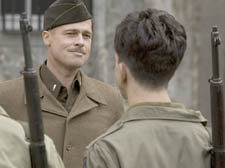|
|
 |
| |

Aldo Raine is played by Brad Pitt in the latest Tarantino film, Inglourious Basterds |
Tarantino’s fairy tale of heroes and how Nazis got their come-uppance
INGLOURIOUS BASTERDS
Directed by Quentin Tarantino
Certificate 18
QUENTIN Tarantino announces at the very beginning of this war film that it is a “fairy
story” set in Nazi-occupied France.
By doing so, he asks you to suspend your
disbelief for the duration, and if you can manage that, it will leave you feeling satisfied in a way recent movies by
Tarantino have singularly failed to.
While not on a par of his first three, which gave him the status he has been living off since – Reservoir Dogs, True Romance and Pulp Fiction – it is a massive return to form after such podgy nonsense as the Kill Bill duo.
The story, split into five “chapters” to make it easier for the director to wade through a multi-pronged plot, goes like this: a beautiful picturehouse proprietor has been approached by German soldier Fredrick Zoller (Daniel Brühl) who wants to use her cinema to host a premiere. It is the story of how he killed a couple of hundred soldiers alone, and Joseph Goebbels has turned his tale into a propaganda flick.
But our cinema owner is not what she seems. She is really Shosanna Dreyfus (Melanie Laurent), a Jewish survivor of a family who were massacred by this film’s truly evil baddie, SS colonel Hans Landa (Christoph Waltz). And the chance to get Hitler, Goebbels, Bormann and other leading Nazis under her roof gives her the chance to wreak revenge.
Meanwhile, we meet a gang of Jewish American soldiers, dropped into occupied France as a hit squad, out to kill as many Nazis as possible and strike fear into the ranks. Led by Aldo Raine (Brad Pitt) they pride themselves on scalping their victims and their reputation for bloodthirsty vengeance. This gang become intertwined, without knowing it, with Shosanna’s plans.
Things clip along at a fair rate: Tarantino knows how to make each scene feel like a set-piece.
Even a slightly saggy middle section does not seem to matter too much: it’s all rather nice to look at and there are some moments of humour, too. His Nazis are cartoonishly bad and appear to be based on the child catcher in Chitty Chitty Bang Bang. It adds to a slightly surreal feel, but helps you accept some re-writing of history that occurs towards the end. |
 |
|
 |
| |
|
 |
|

